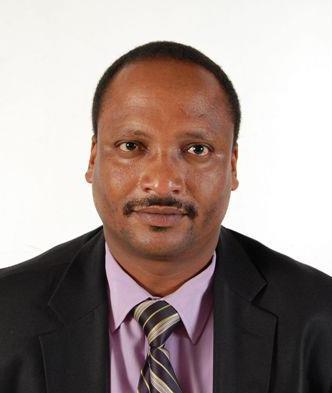
Daniel M. Kobei
Executive Director (OPDP)
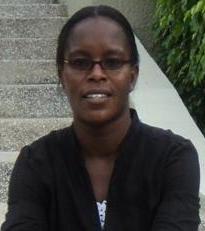
Eunice Chepkemoi
Gender Officer (OPDP)
John Samorai
Programs Officer (OPDP)
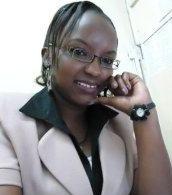
Eunice Ndung'u
Accountant (OPDP)
ABOUT US
OPDP STAFF

Daniel M. Kobei |
 Eunice Chepkemoi |
John Samorai |

Eunice Ndung'u |
OGIEK PEOPLES DEVELOPMENT PROGRAM - (OPDP)
The Ogiek Peoples Development Program (OPDP) was founded in 1999, and registered as a Non-Governmental Organization (NGO) in 2001 by the Kenyan government. It was formed by typical Ogiek elders, opinion leaders, farmers and professionals after long land historical injustices that deprived Ogiek community of its rights as Kenyan citizen. Its aim is to promote and protect Ogiek culture, land, language, environment, and human rights. It is based in Nakuru town and operates in three main counties inhabited by this community namely: - Nakuru, Uasin Gishu, and Narok.
Ogiek means caretaker of all of plants and animals, or scientifically the flora and fauna. The Maasai nicknamed them iltorobo that meant a poor person without herds of cattle. They are a hunter gatherer group and solely depend on the forest for food, medicine, shelter and preservation of their culture. Ogiek being foresters and conservators of nature, they are found in places where trees, birds and wild animals provides them with psychological confort. Ogiek population is being estimated to be approximately 20,000 people, though no exact census have been done clearly targeting this endangered community. Majority of its members live in Mau forest, in the great Rift Valley Province. Due to their small in number, the Ogiek have been an easy target for all kinds of frustrations including those seeking land on which to farm or graze.
Ogiek are the only remaining with largest group among the other hunter gatherer in East Africa. For almost 40 years now, the sporadic displacement of the Ogiek (derogatively referred as Dorobo) has undertaken significant toll on its youth. A generation of youth has been born in this problem that has continue to negotiate elusive solutions e.g. relocation of the Ogiek to non-forest reserves and the commission of enquiring into the land law systems in Kenya (for instance the Njonjo and Ndungu land commissions respectively), besides the formulation of National Land policy.
The Ogiek continue to be denied security, education, employment and opportunity to grow into productive citizens. It is therefore improper to deny people access to her only source of livelihoods. It is also emerges with clarity that the Ogiek live in a different unique time frame with traditional legal provisions that obviously lack integration with the British law that Kenya government subscribes to. This eliminates the fact that the Ogiek require to be understood and be integrated in the national laws.
For over the years hunter Gathering has been a neglected sector and it has been regarded as an unsustainable and primitive/backward lifestyle. This led to social and policy exclusion of the Ogiek community in decision making process that led to continued marginalization of the society in national policy formulation/making process and spheres of development. Poor infrastructure, poverty, insecurity, lack of market, inadequate social facilities and information and low levels of participation in the formal education systems and poor performance characterize Ogiek inhibited areas and these conditions contribute to extreme levels of poverty among the community.
OPDP was founded so as to provide a springboard from which Ogiek community can take a lead role in articulating and advancing their developments, aspirations, priorities and social needs and constantly engaging the government and other shareholders on these issues.
VISION
The Ogiek Peoples' Development Program (OPDP) endeavors to create an environment of tranquility upon which human life and nature prospers for posterity.
MISSION
The OPDP is dedicated to the Ogiek culture, Protection of nature and the improvement of Socio -economic opportunities by way of building the synergies of the Ogiek youth and women through education.
OBJECTIVES
The Ogiek Peoples Development Program (OPDP) has many goals to achieve. These goals channels the OPDP towards achieving these goals.
they include:
The Ogiek are an indigenous people that live in and around the Mau Forest, an area of 900 square kilometers (550 square miles) about 200 kilometers (125 miles) northwest of Nairobi, the capital of Kenya and in the forests around Mt. Elgon at the border to Uganda.
The
Mau forests are the largest remaining block of moist indigenous forests in
Ogiek
depended on the forest for their livelihood. Collection of wild fruits and
nuts, hunting, honey harvesting were a daily routine. At no time was a patch
of forest cleared for farming. The Ogiek had sound management systems that
ensured that there were no forest fire outbreaks. Only the experienced elders
were allowed to make beehives and harvest honey to avoid harming trees.
Harvesting of trees such as Olea euro
and Dobeya goetzeni, mainly used for honey harvesting and herbs was
prohibited. The elders only allowed the use of Juniperus
procera for making hives. The forest was also divided into blocks, each
given to a clan, which divided them according to family lines. Each family was
supposed to take care of its block. The elders had a sound management plan
that ensured these forests remained intact.
Problems
began in 1930 when parts of the Mau were cleared to pave way for forest
plantations using exotic trees. This pushed the Ogiek deeper into the natural
forest. Soon saw millers were issued licenses for logging at very low fees.
This led to intense logging. In 1943, the government introduced the shamba
system to facilitate plantation establishments and food production for the
local people. Problems continued further for the Mau with other peoples being
allowed to settle into the forest and the Ogiek being forced to settle by the
government. The Ogiek do not like the idea, and the government has been
continually evicting them from the forest, while at the same time settling in
outsiders into excised land. No consultations were done with the Ogiek,
neither were alternatives provided.
The Ogiek recognize that they have been the owners of the forests and used indigenous knowledge to sustainably utilize the forests. The Ogiek note that forest destruction in form of charcoal burning, timber harvesting, farming, commercial plantations and grazing is being done by outsides, and this impacts on their use of the unaffected forest areas.
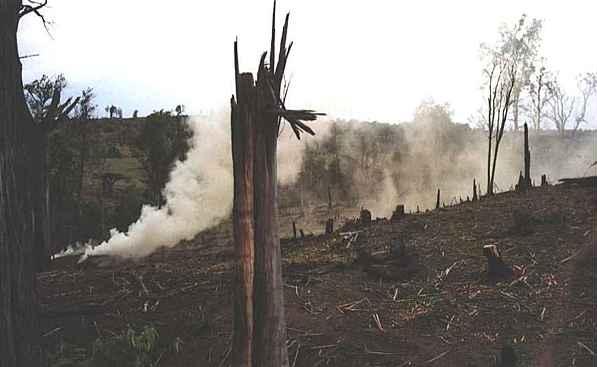
( Mau forest destruction - Copyright by OPDP )
They state that traditional forest management systems need to be incorporated into the management criteria for Mau forest. They advocate sustainable forest management, and promotion of activities that reduce pressure off the forest such as sericulture, butterfly farming, farm forestry and bee keeping. Although these could be solutions, no other form of management of the Mau could work as the Ogiek traditional management system did.
*******************************************************************************************************************
The Ogiek are one of the few remaining hunter-gatherer peoples of East Africa. Their home since time immemorial has been the Mau mountain forest, overlooking Kenya's Rift Valley.
Please visit
our photogallery !
How do they live?
The Ogiek are hunter-gatherers -
some in the deep forest live purely by hunting and gathering, while the majority
grow vegetables and keep livestock also. They have traditionally hunted such
animals as antelope and wild pigs, which is now generally illegal. They gather
not only wild plants, but also honey from beehives which they make from hollow
logs and place in the high branches of the forest trees. Trees at different
heights on the mountain slopes flower at different seasons, meaning that the
Ogiek can collect honey all year round. Its taste varies according to when and
where it is gathered. This honey plays a central part in Ogiek society; it is
used for food and for brewing beer, and also to trade with neighbouring peoples
outside the forest.
What problems do they face?
Ever since colonial times there have been attempts to evict the Ogiek from their ancestral forest, usually on the pretext that they are degrading it. But when the Ogiek are removed, their forest is not protected but rather exploited by logging and tea plantations - some owned by government officials. In some parts of the Mau forest, groups of Ogiek are now resisting eviction, while in others they face influxes of settlers onto their land. The most serious threat currently facing them all comes from the government's plan to open up around one tenth of Kenya's forests - most of it in the Mau forest - to outsiders. This will open the way for more settlers, loggers and tea plantations.
*******************************************************************************************************************
Organizational Profile
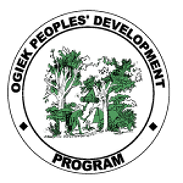
January 2007
1.0 Background information
The Ogiek Peoples Development Program (OPDP) was founded in 1999, and
registered as a non-governmental Organisation in 2001. It was formed by
typical Ogiek elders, opinion leaders, farmers and professionals after long
land historical injustices that deprived Ogiek community of its rights as
Kenyan citizen. Its aim is to promote and protect Ogiek culture, land,
language, environment, and human rights. It is based in Nakuru town and
operates in three main districts inhabited by this community namely: - Nakuru,
Mt. Elgon and Narok.
Ogiek means caretaker of all of plants and animals, or scientifically the
flora and fauna. The Maasai nicknamed them iltorobo that meant a poor
person without herds of cattle. They are a hunter gatherer group and solely
depend on the forest for food, medicine, shelter and preservation of their
culture. Ogiek being foresters and conservators of nature, they are found in
places where tress, birds and wild animals provides them with psycholgical
confort. Ogiek population is being estimated to be approximately 20,000 people,
though no exact census have been done clearly targeting this endangered
community. Majority of its members live in Mau forest, in the great Rift
Valley Province. Due to their small in number, the Ogiek have been an easy
target for all kinds of frustrations including those seeking land on which to
farm or graze.
Ogiek are the only remaining with largest group among the other hunter
gatherer in East Africa. For almost 40 years now, the sporadic displacement of
the Ogiek (derogatively referred as Dorobo) has undertaken significant toll on
its youth. A generation of youth has been born in this problem that has
continue to negotiate elusive solutions e.g. relocation of the Ogiek to
non-forest reserves and the commission of enquiring into the land law systems
in Kenya (for instance the Njonjo and Ndungu land commissions respectively),
besides the formulation of National Land policy.
The Ogiek continue to be denied security, education, employment and
opportunity to grow into productive citizens. It is therefore improper to deny
people access to her only source of livelihoods. It is also emerges with
clarity that the Ogiek live in a different unique time frame with traditional
legal provisions that obviously lack integration with the British law that
Kenya government subscribes to. This eliminates the fact that the Ogiek
require to be understood and be integrated in the national laws.
For over the years hunter Gathering has been a neglected sector and it has
been regarded as an unsustainable and primitive/backward lifestyle. This led
to social and policy exclusion of the Ogiek community in decision making
process that led to continued marginalization of the society in national
policy formulation/making process and spheres of development. Poor
infrastructure, poverty, insecurity, lack of market, inadequate social
facilities and information and low levels of participation in the formal
education systems and poor performance characterize Ogiek inhibited areas and
these conditions contribute to extreme levels of poverty among the community.
These areas includes; Mt. Elgon, Nakuru, Koibatek, and Narok districts.
OPDP was founded so as to provide a springboard from which Ogiek community can
take a lead role in articulating and advancing their developments, aspirations,
priorities and social needs and constantly engaging the government and other
shareholders on these issues.
3.0 Vision
The OPDP endeavors to create and environment of tranquility upon which human
life and nature prospers for posterity
3.1 Mission
The OPDP is dedicated to the Ogiek culture, Protection of nature and the
improvement of socio-economic opportunities by way of building the synergies
of the Ogiek youth and women through education. O.P.D.P gives attention to the
special needs of persons with disability, the youth, the elderly, social
justice, peace, family stability and food security. Its pioneer project area
covers all Ogiek inhabited areas.
3.2 GOALS
3.2.1. Advocate and lobby on Ogiek issues at all levels i.e. local,
national regional and international.
Broad activities
Advance and lobby for policies, laws and practices that advance the course/
position of Ogiek and hunter gatherers development
To strengthen the institutional capacity of Ogiek peoples organization for
effective advocacy and development.
3.2.2. Coordinate learning and sharing of knowledge skills and experiences
between and among Ogieks organizations and key stakeholders through:
Broad activities
Working with Ogiek community and hunter gatherers organizations in
facilitating conflict management in order to create a condusive environment
for sustainable development for hunter gatherers areas
Dissemination of information and facilitate research on issues related to
Ogiek development
Facilitate linkage between Ogiek and OPDP organization and donors or other
sources of funding
Establish a census for all the Ogiek population in their inhibited areas
3.2.3. To enhance gender equity/parity in all aspects of Ogiek coomunity
development including access, ownership/ inheritance through:
Broad activities
Promotion of research in gender
Promoting integration of gender in decision making process
Gender mainstreaming
4.0 OPDP governance
OPDP has a constitution that provides for the:
4.1 Annual General Assembly
This is where OPDP and its Board members meet with the community trustees and
provide a report of its performance. The AGA gives members the opportunity to
influence the direction and mandate of OPDP. It is the source of the OPDP
legitimacy as the members elect or rejects non-performing members of the board.
4.2 Management Board
OPDP has 10 Board members being representatives from every Clan and its
composed of regional balance. All the elected representatives must be
confirmed by the Annual General Assembly.
4.3 SECRETARIAT
The OPDP has a functional/operational secretariat based in Nakuru. The
secretariat is headed and managed by Executive Chairman. In the office are
Program Officer, Accountant, Field Officers and a Secretary.
5.0 Partners
At the moment the network is partnering with: NCIV, UNDESA, MRG, SURVIVAL
INTERNATIONAL,
The partnership support is as tabulated below:
Organization Type of support/partnership
NCIV Collaboration
Support to the legal cases, funding Kshs. 357,000
Support office equipments Kshs. 150,000
UNDESA
Institutional and administrative support
Capacity building on youth, women and opinion leaders
Funding Kshs.700,000 for one year
SURIVAL INTERNATIONAL
Supported exchange visit to the Bushmen Kshs.269,000
Supported air ticket to attend Bushmen court case Kshs.82,000
SYLVIE TARGAMA
Supported a one day medical camp at Kshs. 20,000
Donated drugs
ARID and SEMI ARID INSTITUTE
Supported the facilitation of the meeting between the Ogiek and the Special
Rapportour visit to Mau Forest at Kshs. 40,000 Other partners
Efforts are being pursued to engage them and explore areas of possible
collaboration
7.0 Activities
The following are what we have managed to accomplish, current activities and
priority needs for smooth running of the network:
Past activities Current activities
Priority need
Participated in the National Constitutional conference
Civic Education on Proposed New Constitution
Cultural Exhibitions
Medical Camps
Legal cases
Bee Keeping and honey marketing
Establishment of OPDP partners for new activities
Resource mobilization.
Networking and partnership building
Marketing OPDP.
Organizational Internal Assessment.
Development of Strategic Plan.
Girl child education in Mau forest.
Institutional / organizational capacity development.
Networking and partnership building with like minded organization for
efficient service delivery.
Resource Mobilization.
Exchange visits to learn best practices that strengthen sustainable hunter
gatherer livelihoods and network management.
Resource centre and census on Ogiek population, coordination and exchange of
information.